AMD's Radeon HD 5870: Bringing About the Next Generation Of GPUs
by Ryan Smith on September 23, 2009 9:00 AM EST- Posted in
- GPUs
Power, Temperature, & Noise
As we have mentioned previously, one of AMD’s big design goals for the 5800 series was to get the idle power load significantly lower than that of the 4800 series. Officially the 4870 does 90W, the 4890 60W, and the 5870 should do 27W.
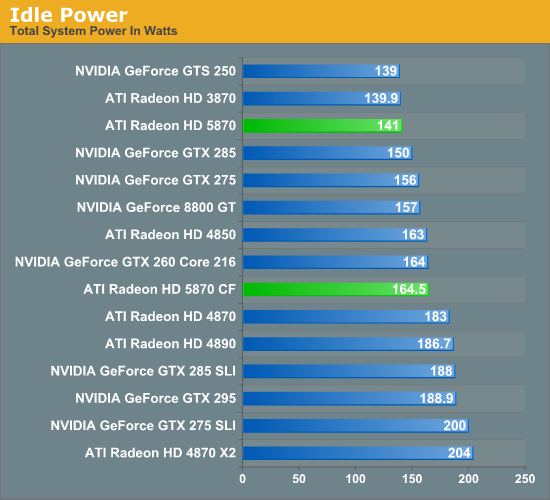
On our test bench, the idle power load of the system comes in at 141W, a good 42W lower than either the 4870 or 4890. The difference is even more pronounced when compared to the multi-GPU cards that the 5870 competes with performance wise, with the gap opening up to as much as 63W when compared to the 4870X2. In fact the only cards that the 5870 can’t beat are some of the slowest cards we have: the GTS 250 and the Radeon HD 3870.
As for the 5870 CF, we see AMD’s CF-specific power savings in play here. They told us they can get the second card down to 20W, and on our rig the power consumption of adding a second card is 23.5W, which after taking power inefficiencies into account is right on the dot.
Moving on to load power, we are using the latest version of the OCCT stress testing tool, as we have found that it creates the largest load out of any of the games and programs we have. As we stated in our look at Cypress’ power capabilities, OCCT is being actively throttled by AMD’s drivers on the 4000 and 3000 series hardware. So while this is the largest load we can generate on those cards, it’s not quite the largest load they could ever experience. For the 5000 series, any throttling would be done by the GPU’s own sensors, and only if the VRMs start to overload.
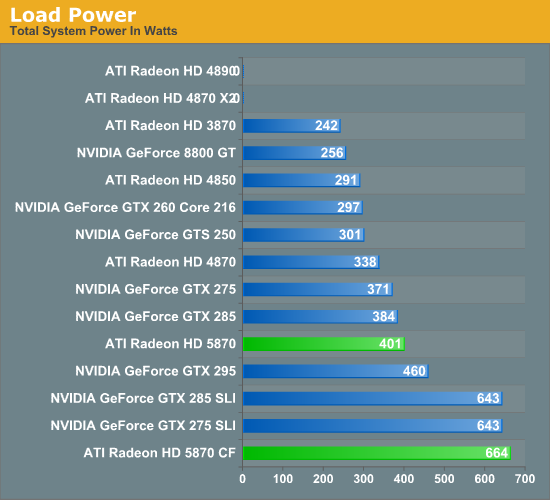
In spite of AMD’s throttling of the 4000 series, right off the bat we have two failures. Our 4870X2 and 4890 both crash the moment OCCT starts. If you ever wanted proof as to why AMD needed to move to hardware based overcurrent protection, you will get no better example of that than here.
For the cards that don’t fail the test, the 5870 ends up being the most power-hungry single-GPU card, at 401W total system power. This puts it slightly ahead of the GTX 285, and well, well behind any of the dual-GPU cards or configurations we are testing. Meanwhile the 5870 CF takes the cake, beating every other configuration for a load power of 664W. If we haven’t mentioned this already we will now: if you want to run multiple 5870s, you’re going to need a good power supply.
Ultimately with the throttling of OCCT it’s difficult to make accurate predictions about all possible cases. But from our tests with it, it looks like it’s fair to say that the 5870 has the capability to be a slightly bigger power hog than any previous single-GPU card.
In light of our results with OCCT, we have also taken load power results for our suite of cards when running World of Warcraft. As it’s not a stress-tester it should produce results more in line with what power consumption will look like with a regular game.

Right off the bat, system power consumption is significantly lower. The biggest power hogs are the are the GTX 285 and GTX 285 SLI for single and dual-GPU configurations respectively. The bulk of the lineup is the same in terms of what cards consume more power, but the 5870 has moved down the ladder, coming in behind the GTX 275 and ahead of the 4870.
Next up we have card temperatures, measured using the on-board sensors of the card. With a good cooler, lower idle power consumption should lead to lower idle temperatures.
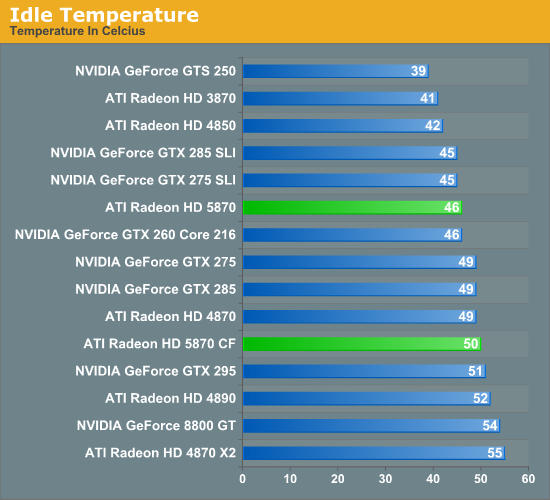
The floor for a good cooler looks to be about 40C, with the GTS 250, 3870, and 4850 all turning in temperatures around here. For the 5870, it comes in at 46C, which is enough to beat the 4870 and the NVIDIA GTX lineup.
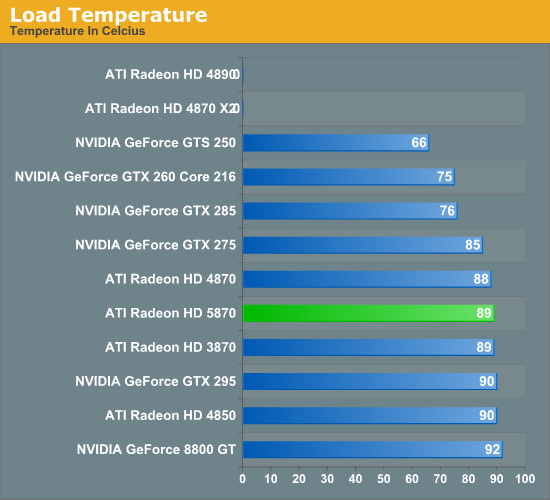
Unlike power consumption, load temperatures are all over the place. All of the AMD cards approach 90C, while NVIDIA’s cards are between 92C for an old 8800GT, and a relatively chilly 75C for the GTX 260. As far as the 5870 is concerned, this is solid proof that the half-slot exhaust vent isn’t going to cause any issues with cooling.
Finally we have fan noise, as measured 6” from the card. The noise floor for our setup is 40.4 dB.

All of the cards, save the GTX 295, generate practically the same amount of noise when idling. Given the lower energy consumption of the 5870 when idling, we had been expecting it to end up a bit quieter, but this was not to be.
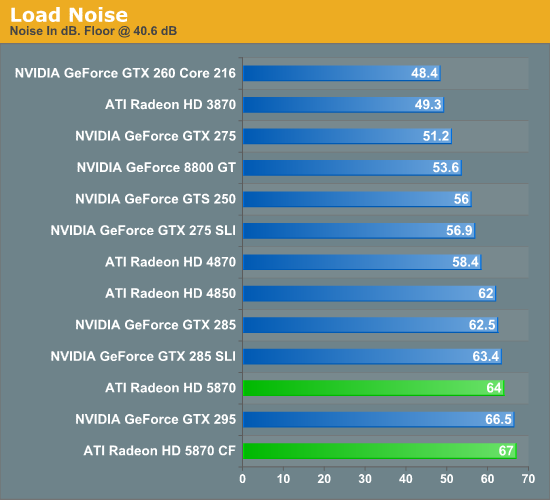
At load, the picture changes entirely. The more powerful the card the louder it tends to get, and the 5870 is no exception. At 64 dB it’s louder than everything other than the GTX 295 and a pair of 5870s. Hopefully this is something that the card manufacturers can improve on later on with custom coolers, as while 64 dB at 6" is not egregious it’s still an unwelcome increase in fan noise.










327 Comments
View All Comments
Ryan Smith - Wednesday, September 23, 2009 - link
The load temp is the same as a single card.ilnot1 - Wednesday, September 23, 2009 - link
Does anyone have a link to any review that compares 4850's, 4870's, and 4890's in Crossfire against the 5870 & 5870 CF setup?T2k - Wednesday, September 23, 2009 - link
FWIW: http://www.techpowerup.com/reviews/AMD/HD_5870_PCI...">http://www.techpowerup.com/reviews/AMD/HD_5870_PCI...T2k - Wednesday, September 23, 2009 - link
Ehh, I meant: http://www.techpowerup.com/reviews/ATI/Radeon_HD_5...">http://www.techpowerup.com/reviews/ATI/Radeon_HD_5...ilnot1 - Wednesday, September 23, 2009 - link
Thanks T2k, but the only cards that are in Crossfire in that review are the 58XX's. There are no other comparisons to cards in CF or SLI. Since Ryan included some of the most recent nVida cards in SLI I was hoping to find the 48XX's in CF.T2k - Thursday, September 24, 2009 - link
Basically the rule of thumb seems to be that at 1920x1200 a single 5870 is still slightly slower than 4870X2 and probably slightly faster than a 4850X2 2GB.I own the latter so I will wait this time - either they lower the initial price of the 5870X2 or they release a 5850X2, otherwise I'll pass because single 5870 is simply OVERPRICED as it is already.
T2k - Wednesday, September 23, 2009 - link
Seriously: we get a very nice technical background section - then you top it with this more than idiotic collection of games for testing, leaving out 4850X2 2GB, 5850, using TWO stupid CryEngine-based PoS from Crytek, the most un-optimized code producers or WoW, of which even you admit it's CPU-bounded but now CoD:WaW, no Clear Sky, no UT3 or rather a single current Unreal Eninge-based game?Benchmarking part is ALMOST WORTHLESS, the only useful info is that unless you go above 1920x1200 the 4870X2 pretty much owns 5870's @ss as of now.
Ryan Smith - Wednesday, September 23, 2009 - link
For what it's worth, Batman: Arkham Asylum is UE3 engine based.T2k - Wednesday, September 23, 2009 - link
OK, I missed that (probably because I found the game shots ugly and became uninterested.)But how about ET:QW? Yes, it's not the best looking game but it is still popular, let alone World at War which is both great looking and crazy popular, let alone Clear Sky which is a very demanding DX10.1 game? Where is Fallout 3? Where is Modern Warfare?
FFS the most demanding are the quick ation-shooters and we, FPS players are the first one to upgrade to new cards...
Werelds - Thursday, September 24, 2009 - link
How would ET:QW be a good benchmark? Last I checked, it's still limited to the 30 FPS animations, which makes running it at more than 30 FPS pointless because everything will look jerky.I agree something like the CoD games should be included for comparison's sake, but they're hardly a good benchmark or taxing on a system. QW does not fall into the same category though, it has a smaller active playerbase than even L4D which lost a lot of players due to the lack of updates.